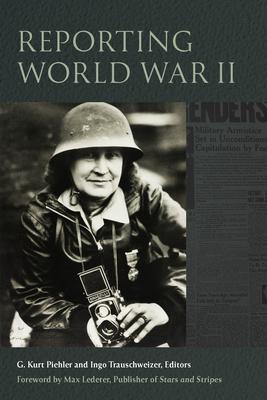This set of essays offers new insights into the journalistic process and the pressures American front-line reporters experienced covering World War II. Transmitting stories through cable or couriers remained expensive and often required the cooperation of foreign governments and the American armed forces. Initially, reporters from a neutral America documented the early victories by Nazi Germany and the Soviet invasion of Finland. Not all journalists strove for objectivity. During her time reporting from Ireland, Helen Kirkpatrick remained a fierce critic of that country’s neutrality. Once the United States joined the fight after the Japanese attack on Pearl Harbor, American journalists supported the struggle against the Axis powers, but this volume will show that reporters, even when members of the army sponsored newspaper, Stars and Stripes were not mere ciphers of the official line.
African American reporters Roi Ottley and Ollie Stewart worked to bolster the morale of Black GIs and undermined the institutional racism endemic to the American war effort. Women front-line reporters are given their due in this volume examining the struggles to overcome gender bias by describing triumphs of Thérèse Mabel Bonney, Iris Carpenter, Lee Carson, and Anne Stringer. The line between public relations and journalism could be a fine one as reflected by the U.S. Marine Corps’ creating its own network of Marine correspondents who reported on the Pacific island campaigns and had their work published by American media outlets. Despite the pressures of censorship, the best American reporters strove for accuracy in reporting the facts even when dependent on official communiqués issued by the military. Many wartime reporters, even when covering major turning points, sought to embrace a reporting style that recorded the experiences of average soldiers. Often associated with Ernie Pyle and Bill Mauldin, the embrace of the human-interest story served as one of the enduring legacies of the conflict. Despite the importance of American war reporting in shaping perceptions of the war on the home front as well as shaping the historical narrative of the conflict, this work underscores how there is more to learn. Readers will gain from this work a new appreciation of the contribution of American journalists in writing the first version of history of the global struggle against Nazi Germany, imperial Japan, and fascist Italy.| FindBook |
有 1 項符合
Reporting World War II的圖書 |
 |
Reporting World War II 出版社:Fordham University Press 出版日期:2023-04-25 語言:英文 規格:精裝 / 304頁 / 普通級/ 初版 |
| 圖書館借閱 |
| 國家圖書館 | 全國圖書書目資訊網 | 國立公共資訊圖書館 | 電子書服務平台 | MetaCat 跨館整合查詢 |
| 臺北市立圖書館 | 新北市立圖書館 | 基隆市公共圖書館 | 桃園市立圖書館 | 新竹縣公共圖書館 |
| 苗栗縣立圖書館 | 臺中市立圖書館 | 彰化縣公共圖書館 | 南投縣文化局 | 雲林縣公共圖書館 |
| 嘉義縣圖書館 | 臺南市立圖書館 | 高雄市立圖書館 | 屏東縣公共圖書館 | 宜蘭縣公共圖書館 |
| 花蓮縣文化局 | 臺東縣文化處 |
|
|
圖書介紹 - 資料來源:博客來 評分:
圖書名稱:Reporting World War II
內容簡介
作者簡介
G. Kurt Piehler (Edited By)
G. Kurt Piehler is author of Remembering War the American Way (2004) and A Religious History of the American GI in World War II (2021). Piehler edits the book series: World War II: The Global, Human, Ethical Dimension for Fordham University Press. He is a member of the editorial board of the Service Newspapers of World War II digital publication (Adam Mathews) and on the advisory board of the NEH funded American Soldier Project at Virginia Tech University (americansoldierww2.org). He also served as the lead curator for the exhibit, "Rendezvous with Destiny: Florida and World War II" at the Florida Historic Capitol Museum (December 7, 2021-March 20, 2022).
Ingo Trauschweizer is author of The Cold War US Army (2008) and Maxwell Taylor’s Cold War (2019). He is also the editor or co-editor of Failed States and Fragile Societies (2014), Temple of Peace? (2021), and Religion and Peace (2022). He edits the book series War and Society in North America for Ohio University Press. From 2017 to 2022 he directed the Contemporary History Institute at Ohio University, where he also serves as professor of history.
|










